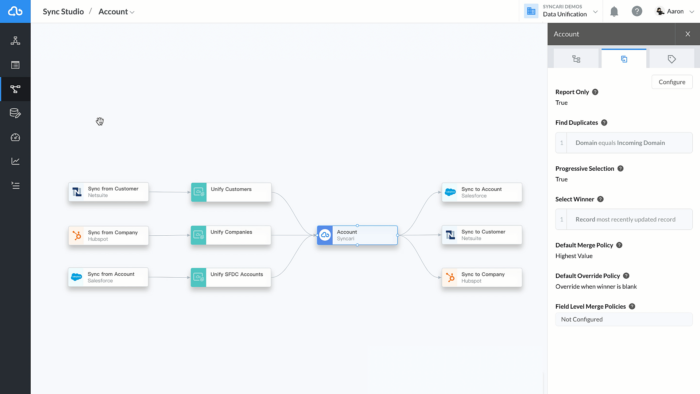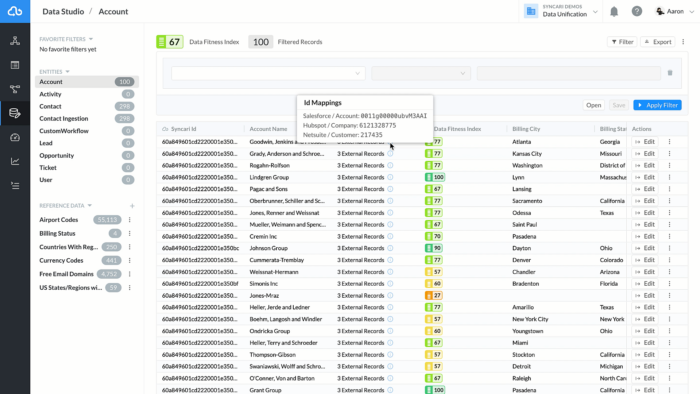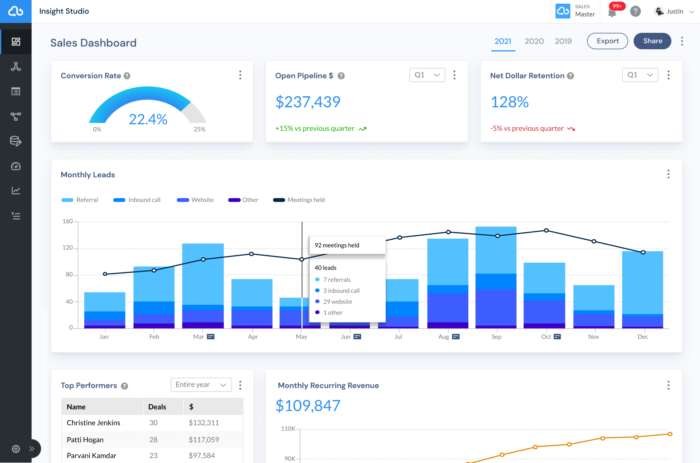There are many terms involved in data and how it is managed. Here we’ll do with a rising trend, usually seen in discussions of revenue operations and their objective to unify data for their sales, marketing, customer success and finance teams.
What is data unification?
Put simply, data unification is the outcome of work done to stitch together data from disparate sources. For example, data about your customer exists in Hubspot, Salesforce and NetSuite. Your customers don’t know this, and it feels odd to them when this data is out of sync. Unifying, standardizing, normalizing and deduplicating attributes about this customer from those business systems and resolving conflicts results in unified data. To ensure this unification persists, Hubspot, Salesforce and NetSuite must then be kept in sync as better data emerges.
Why unify my data?
With unified data, every department operates with a shared and trusted view of what’s happening across the business and throughout the customer journey. Unified data enables clean handoffs between departments, drives coordinated customer outreach based on key signals (e.g. opportunity flips to closed won) and shifts the focus of “data-driven” conversations from arguing over whose data is correct to how insights should be interpreted and used to grow the business.
Data unification is foundational for business alignment. When you have unified data, Aaron Landgraf in Hubspot is the same as Aaron Landgraf in Salesforce, NetSuite and your product database. Attributes about Aaron are constantly being refreshed as better data emerges in any of those systems. And Forrester research> shows that highly aligned companies grow 19% faster and are 15% more profitable.
Why is data unification hard?
We see four primary reasons that businesses drag their feet on data unification:
- Lack of ownership: no single department has the knowledge, authority, or autonomy to drive the unification of data across the org.
- Data unification forces the business to agree on common definitions and shared standards. As an example, how does your business define a customer or ACV? Are those definitions shared across Marketing, Sales, Product, and Finance? When Marketing pulls a report on customers from Hubspot, does it match the result returned from Salesforce or NetSuite? You’d be surprised how often the answer is no.
- Data unification efforts are fractured across multiple vendors, often owned by different departments with specialized users. At a minimum, you need tools to sync, store, model, and manage your data – and that doesn’t even account for analytics, which is where many organizations start. Operating efficiently with this many data tools is impractical.
- Data unification is a job that’s never quite finished. Business requirements and definitions are ever-changing and new data sources are constantly being added. Achieving data unification without some level of data automation is impractical.
How is data unification different from Customer 360?
Data unification is a critical enabler of Customer 360. You must first stitch together related customer attributes based on some unique identifier and refine this data until you create a golden customer record. This is data unification.
Many organizations focus on getting their 360 degree view of the customer only inside CRM, often at the guidance of CRM vendors who claim to deliver a unified view with their solution alone. However, this misses the larger opportunity. Customer 360 initiatives are most impactful when every group in the company can specify the portion of the Customer 360 view that is specific to their role and is available in the system where they work. At Syncari, we call this Distributed Customer 360, and we believe it’s critical to aligning GTM teams and personalizing and coordinating customer activities.
Why Syncari for data unification?
Syncari was purpose-built to align, analyze and activate data across every system in the customer journey, from leads to billings. Our full-stack data automation platform empowers business users to stitch together cross-system data visually in our fully managed data hub, govern that data with no-code policies, and keep every system in sync as better data emerges, automatically.
How does Syncari deliver data unification?
Step 1: Access your data with our self-healing Syncari Synapses.
Unlocking data with Syncari is simple and secure. Input your credentials (username, password, token) and Syncari will create a deep connection to your end systems. Syncari Synapses securely access data and metadata, monitor for data and schema changes, are responsive to system outages and work continuously to keep all systems in sync based on your governance rules and logic.

Step 2: Decide your unification criteria: With newfound access to your cross-system data and metadata, you can map entities and fields from every system to Syncari’s unified data model and define the relationships between them. In the visual below, we are mapping NetSuite customers, Hubspot companies and Salesforce accounts to the Syncari account entity based on a shared domain (e.g. syncari.com) and then syncing unified data back out to the operational systems. All this is done without writing a single line of code.

After unification is complete, you can define rules and logic that operate across every connected system – a capability unique to Syncari and a outcome of our data-model driven approach:
-
- Cross-system merge and deduplication
- Centralize enrichment with multiple 3rd party or reference data sets
Standardize key values (e.g. state/country)
Normalize data formats (e.g. proper case first name)
Sums, aggregations, rollups and cross-object lookups
Step 3: Explore cross-system data centrally
Interact with previously fragmented data directly within Syncari’s SOC II Type 2 compliant data hub. The example below shows 100 unique records from Salesforce, NetSuite and Hubspot being unified into 100 unique, complete records in Syncari. From Data Studio, you can actually see how the data stitching was done using the unique IDs of the cross-functional records to avoid the creation of 300 records.
Now a data change in any of your systems (or made directly in Syncari) will be automatically synced across every connected system based on your data management and governance rules and policies.

Step 4: Analyze performance with full-funnel visualizations
Visualize GTM performance from a set of pre-built or custom reports and dashboards that utilize the unified data model and trusted data and metrics. These dashboards are updated in real-time and contain data that will exactly match what’s in department systems, eliminating biased metrics and reporting. Organizations with existing BI investments can point these tools directly at Syncari.

Step 5: Activate signals and insights instantly
Identify and distribute key revenue signals back to the people that need them, in the systems where they work. Whether it’s routing inbound leads to the right owner, alerting success reps in Slack when a customer exceeds usage capacity or triggering myriad workflows across the business when an opportunity flips to closed won – with Syncari, you have confidence interconnected workflows will execute with optimal, unified data.
Start your unlimited trial today.


